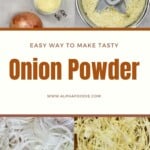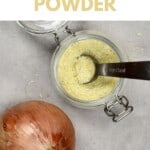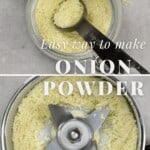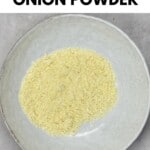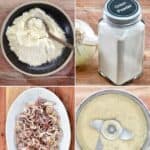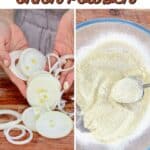This post may contain affiliate links. Please read our disclosure policy.
How to make onion powder at home with either a dehydrator, oven, or air-drying. Not only is this a great way to preserve onions, but there are also tons of ways to use the resulting dehydrated onion powder!
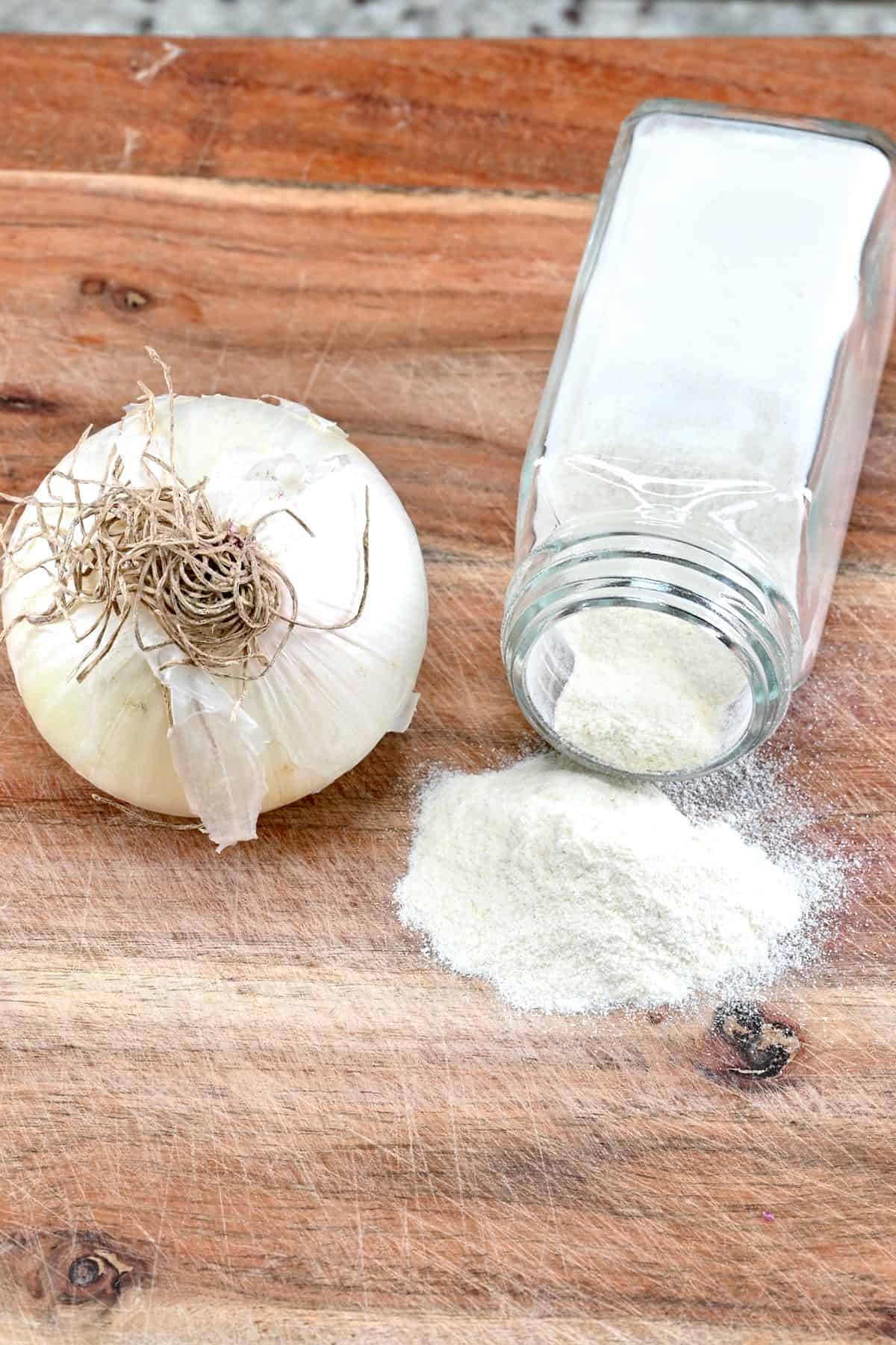
I have already posted DIYs for dehydrating recipes including onion flakes, and garlic flakes & powder. In addition, you can check out the DIY section on the blog for my complete list of food DIYs.
Onion powder is one of my all-time favorite low-effort food seasonings for those days when I don’t want to deal with chopping onions. Not to mention that it’s also tear-free, and homemade versions will avoid any nasty additives that can be found in store-bought options.

Moreso, onion powder is a great way to preserve large amounts of homegrown (or store-bought) onions, plus the powder is more cost-effective, tastier, and contains no preservatives, fillers, or anti-caking agents!
Want to save this recipe?
How To Make Onion Powder
Step 1: Prepare the Onion
Peel and slice the onions with a knife or mandoline (for even slices) at a maximum of 1/8 inch thickness (3 mm).
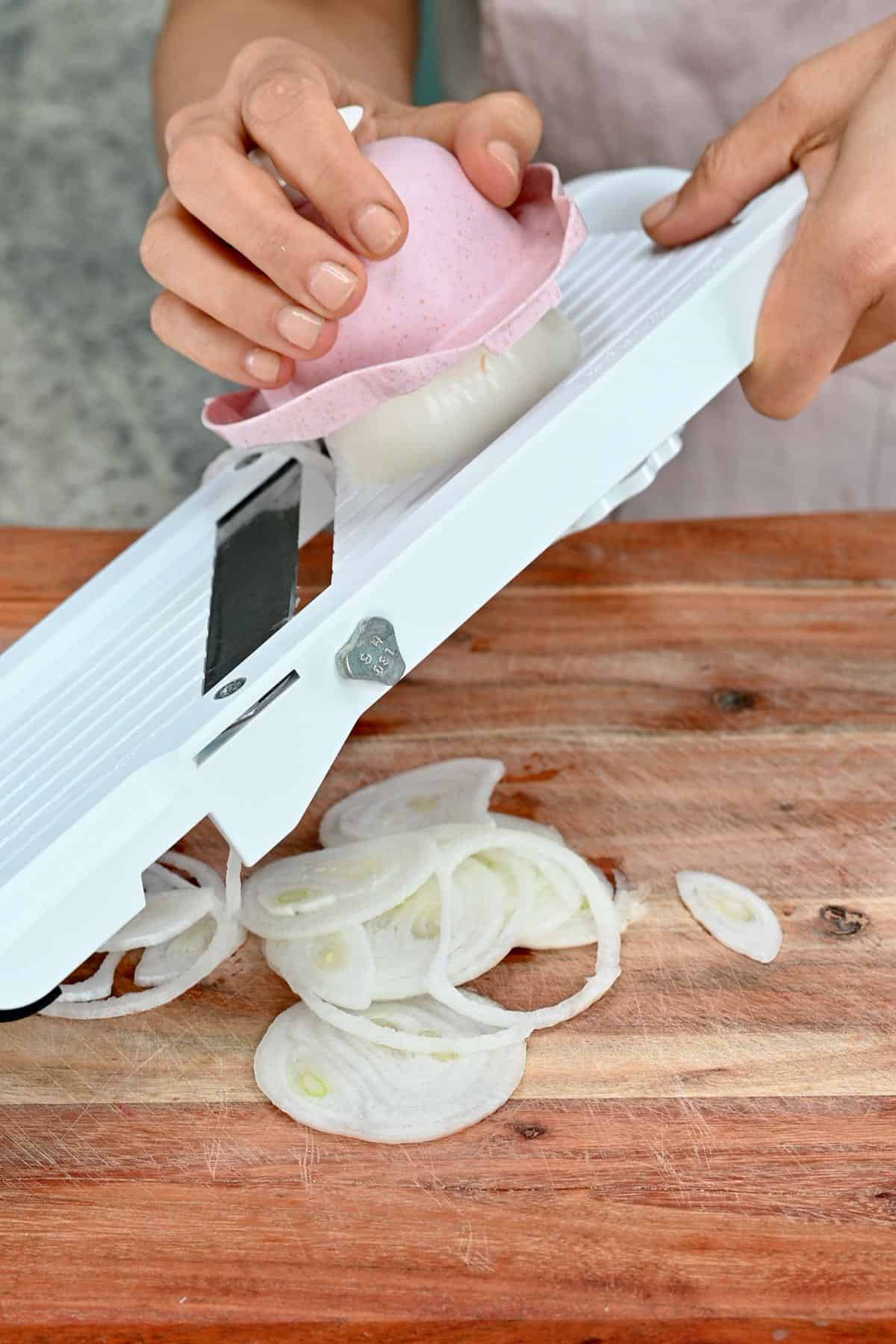
Chef’s Tip: For dried minced onion you can use a food processor/chopper for just a few seconds or using a mandoline and then finely mince with a knife.
For more tips on how to peel and slice onions, check my step-by-step guide.
Step 2: Dehydrate the Onion
With a dehydrator
Lay the thinly sliced onion over the dehydrator trays in a single layer, taking care not to make them overlap.
Dehydrate at 150ºF/66ºC for 6-8 hours (if high humidity, around 80%) or 4-6 hours (if low humidity) until completely dry.
They are ready when they snap when trying to bend. If they’re at all pliable, they need more time.
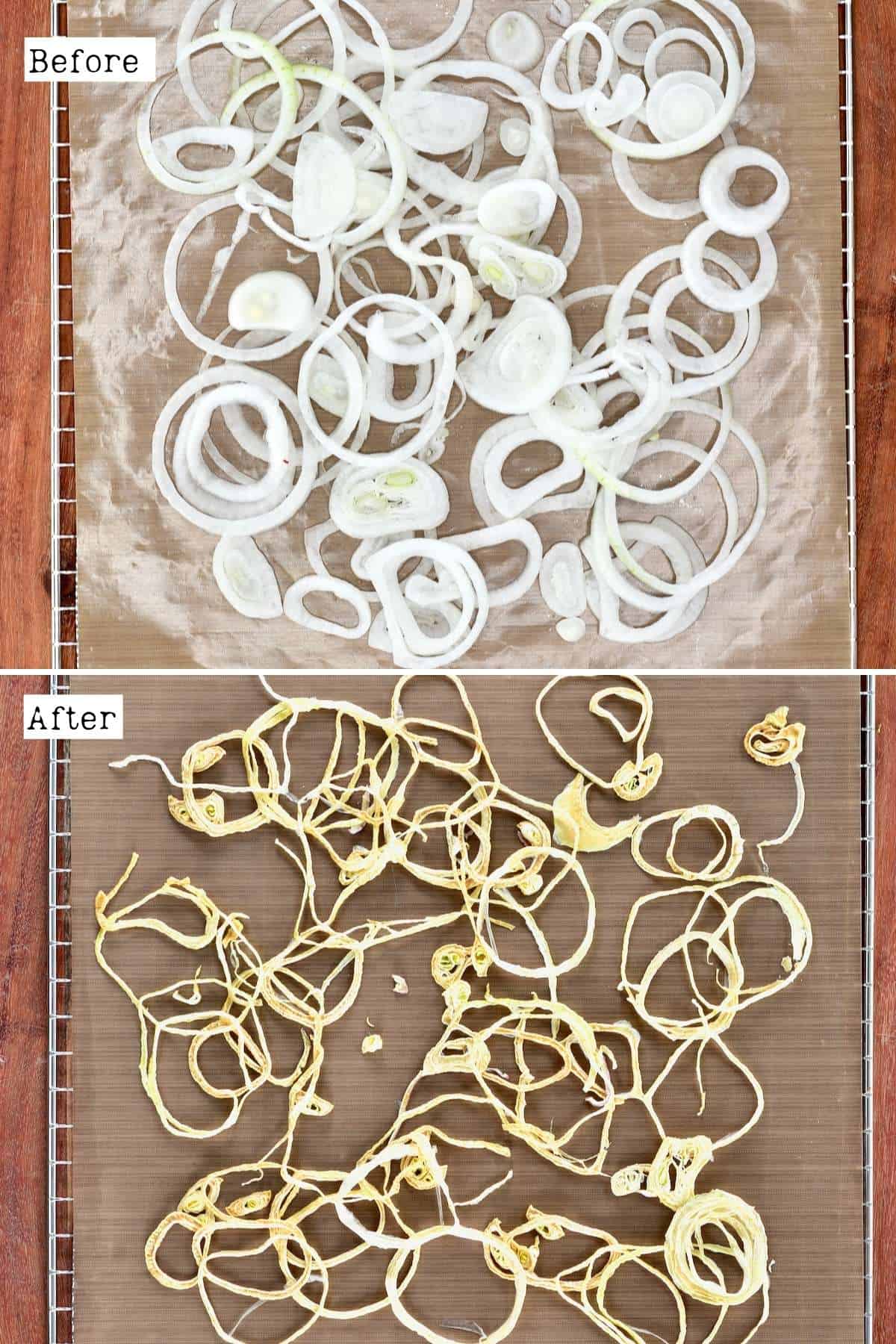
With an oven
Spread the onion pieces over parchment-lined baking sheets, making sure the pieces don’t touch or overlap and then place them in the oven at its lowest temperature. It’s best if the temperature is around 130-150ºF/54-66ºC.
If your oven doesn’t go as low as that, then choose the lowest temperature and prop open the door with the handle of a wooden spoon or something similar, to allow for better airflow and for the steam to escape as the onion dehydrates.
Check on the onion hourly, optionally flipping it over a couple of times, to dry it faster.

Remove from the oven when it snaps rather than bends, or at least has a very little bend (as it should continue to crisp while cooling). Once cool, it should snap rather than bend. If not, then it’ll have to go back into the oven again.
Sun-Drying
Place the onion slices on a large kitchen towel/cloth or paper-lined baking tray and leave them in a well-ventilated area, near a window (if possible).
This option is best for warmer, non-humid climates with lots of sunshine. Colder and more humid areas will affect the drying time.
Flip the onion pieces a few times to speed up the process.
This method can take a few days based on the onion’s thickness, weather, and humidity.
Step 3: Grind the flakes into onion powder
You can use a food processor, blender, coffee/spice grinder, or even mortar & pestle to grind the dehydrated onion into onion powder.
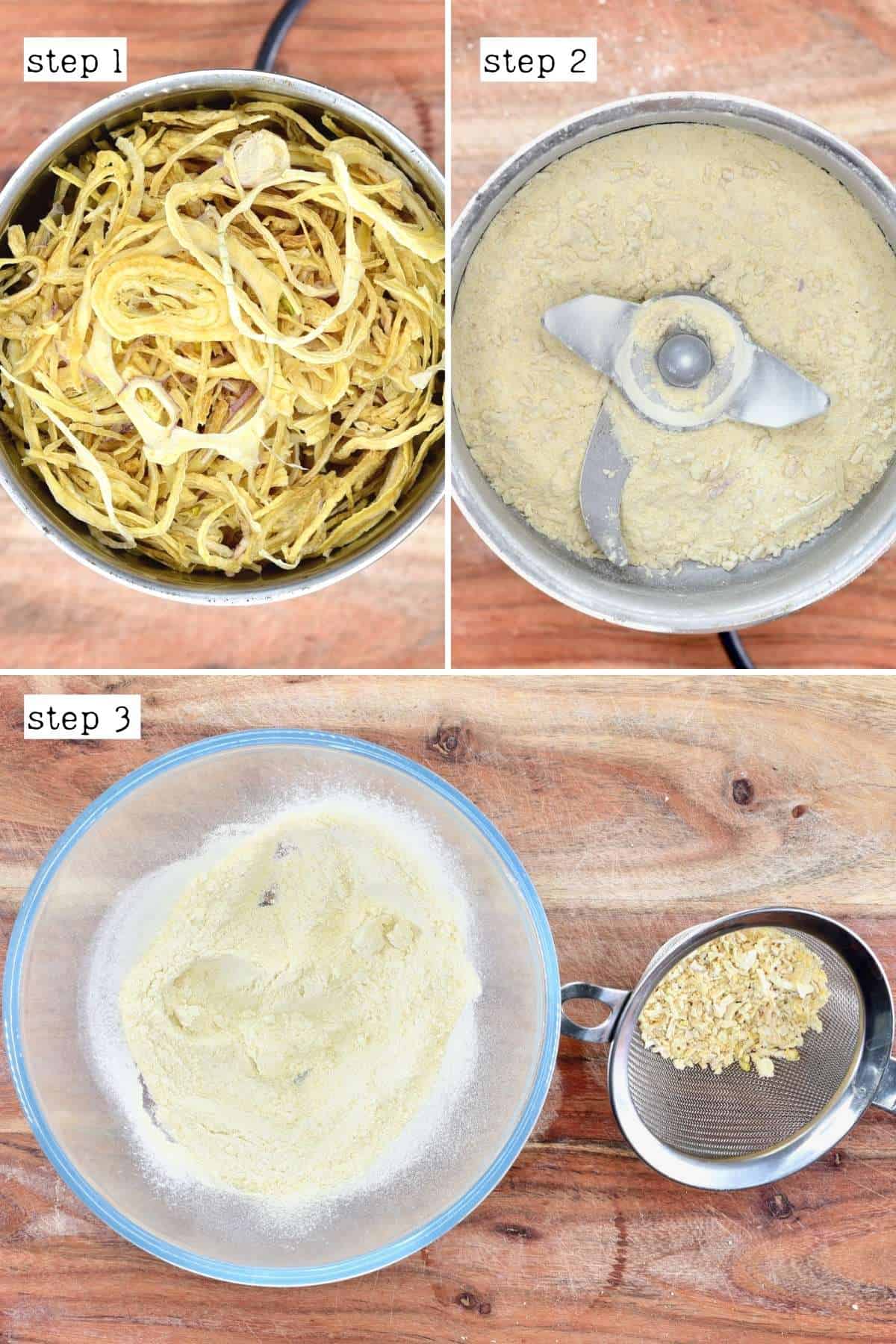
Once ground, sift the fine powder through a sieve and re-grind any leftover larger bits. The onion powder is ready.
How To Store
The onion powder can be stored in an airtight spice jar in a cool, dry location – like a kitchen cupboard. When stored properly, this powder can be kept indefinitely, though the flavor will begin to decrease after around a year.
Give the jars a shake the first few days after dehydration, to break up any errant clumps, and optionally place some uncooked rice or beans in the jar to absorb any extra moisture, to avoid clumping.

How To Use
Here are just a few ways that I enjoy using the dehydrated onion powder.
- In any recipe that calls for fresh onion.
- In or over bread and other savory baked goods – like bagels, buns, or bread. Like this Simple Homemade Multigrain Bread Recipe. Or even pizza crusts like this traditional pizza, butternut squash pizza, or cauliflower pizza.
- Add to soups & stews – like this Japanese-inspired Ramen Noodle Soup or Turmeric, Ginger & Pumpkin Immune Boosting Soup.
- For burgers, falafels, and meatballs.
- Dissolve into dressings, marinades, and sauces– like this Lemon Herb Tahini Sauce, Marinara Sauce, or Easy Raspberry Salad Dressing. Or add to Homemade Vegetable Bouillon Cubes and Powder.
- In dips or used to garnish – like Rainbow Hummus 6 ways, Simple Spinach Yogurt Dip (Borani), or Smoky Eggplant Dip (Baba Ganoush).


- Over or in egg dishes – like scrambled, fried, soft/hard-boiled, as well as Omelettes (with tips) and Fluffy Cloud Eggs.
- To season roasted snacks – like nuts or these Lightly Spiced Easy Crispy Chickpeas or this Coconut Bacon.
- Within seasoning, herb, and spice blends – like everything bagel seasoning, Simple Homemade Italian Seasoning, or Simple Mexican Seasoning (Mexican Spice Blend).
- In batter for frying – works amazingly alongside paprika and garlic powder.
- To season veggies and proteins – including Crispy Baked Fries and Roasted Purple Potatoes.
- For other potato dishes – like mashed potato and baked potatoes or even homemade sour cream and onion flavor chips!

Recipe Notes
- How much onion powder equals one onion? 1 tablespoon of onion powder is equal to one medium onion or around 1/2 cup chopped raw onion or 1/4 cup minced onion.
- Onion powder vs onion salt? Onion salt is a mixture of onion powder and salt. Use a ratio of 3:1 parts salt vs onion powder (e.g. 3 tsp salt to 1 tsp onion powder).
- If you use a food processor to grind the onion into powder, allow it to settle for a minute or two before opening it, otherwise, the powder tends to go everywhere!
- You can use the onions of your choice, though they will all affect the flavor in different ways.
- If you’re using homegrown onions, you can also dry the green leaves but the time to dry the leaves vs. bulb will differ.
Related DIYs/Recipes
- How to Make Fried Onions (Crispy Onions/Birista)
- Simple Roasted Onions
- How to Make Beetroot Chips (Baked or Dehydrated)
- Simple Golden Spice (Golden Milk Powder)
- How To Make Garlic Powder
- How To Make Garlic Flakes
- DIY Onion Flakes
- How to Make Ginger Powder (Two Methods)
- How To Make Crispy Ginger Chips
- DIY Turmeric powder at home
- How to Use Ginger in 40+ Ways (Chop, Prepare, and Use Ginger)
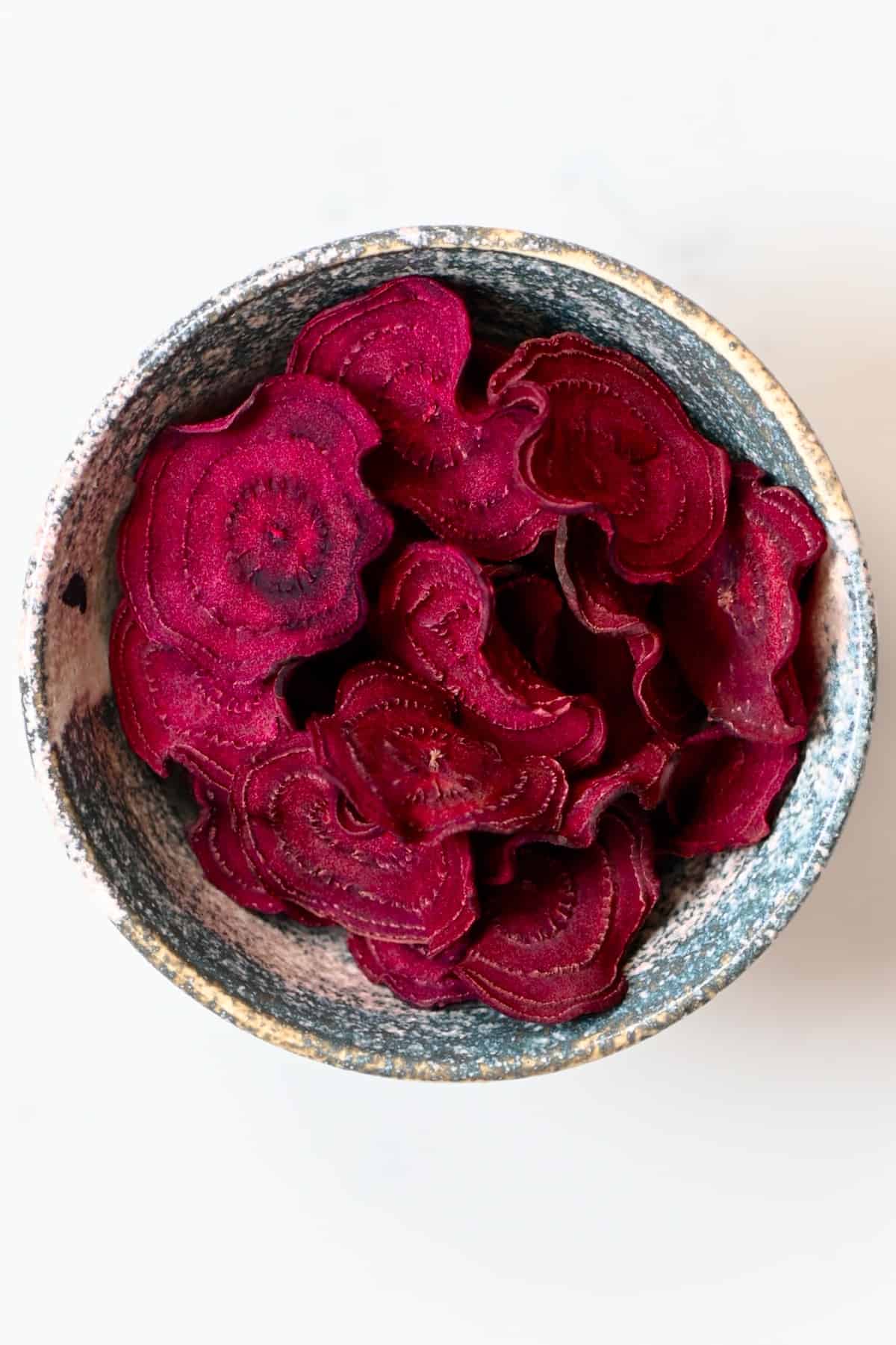
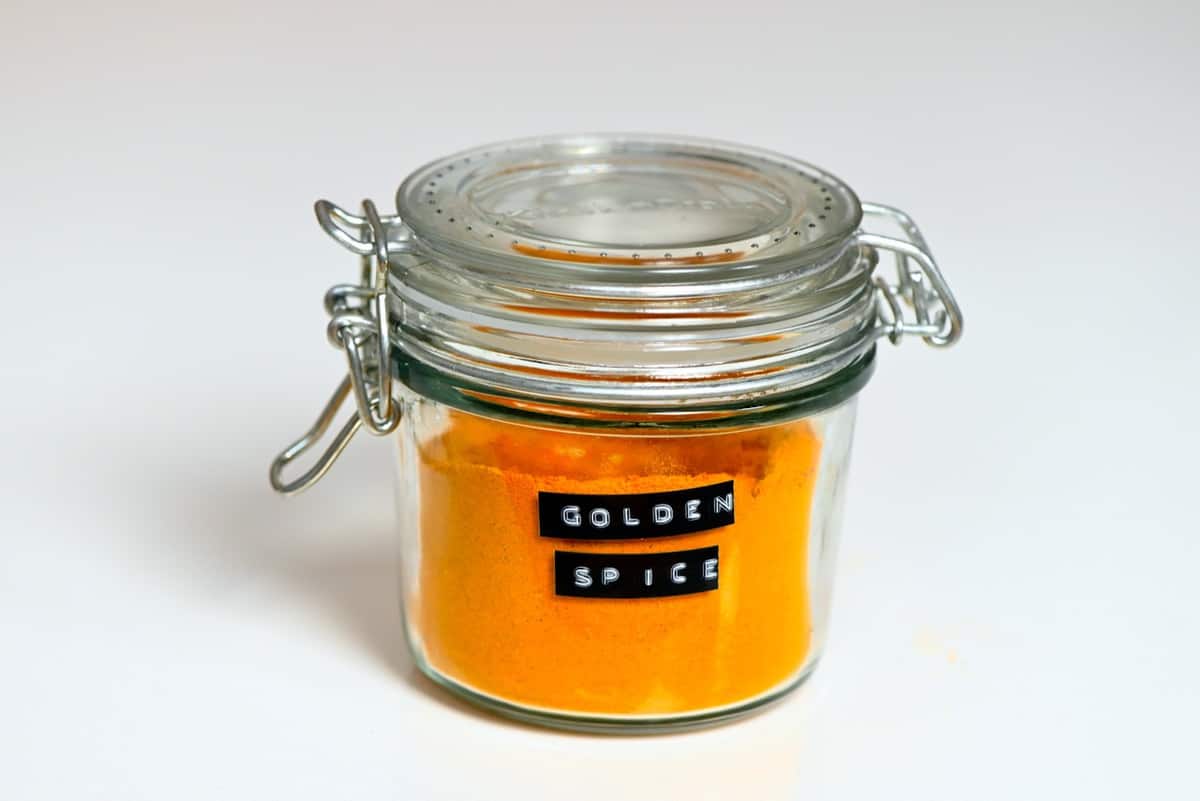
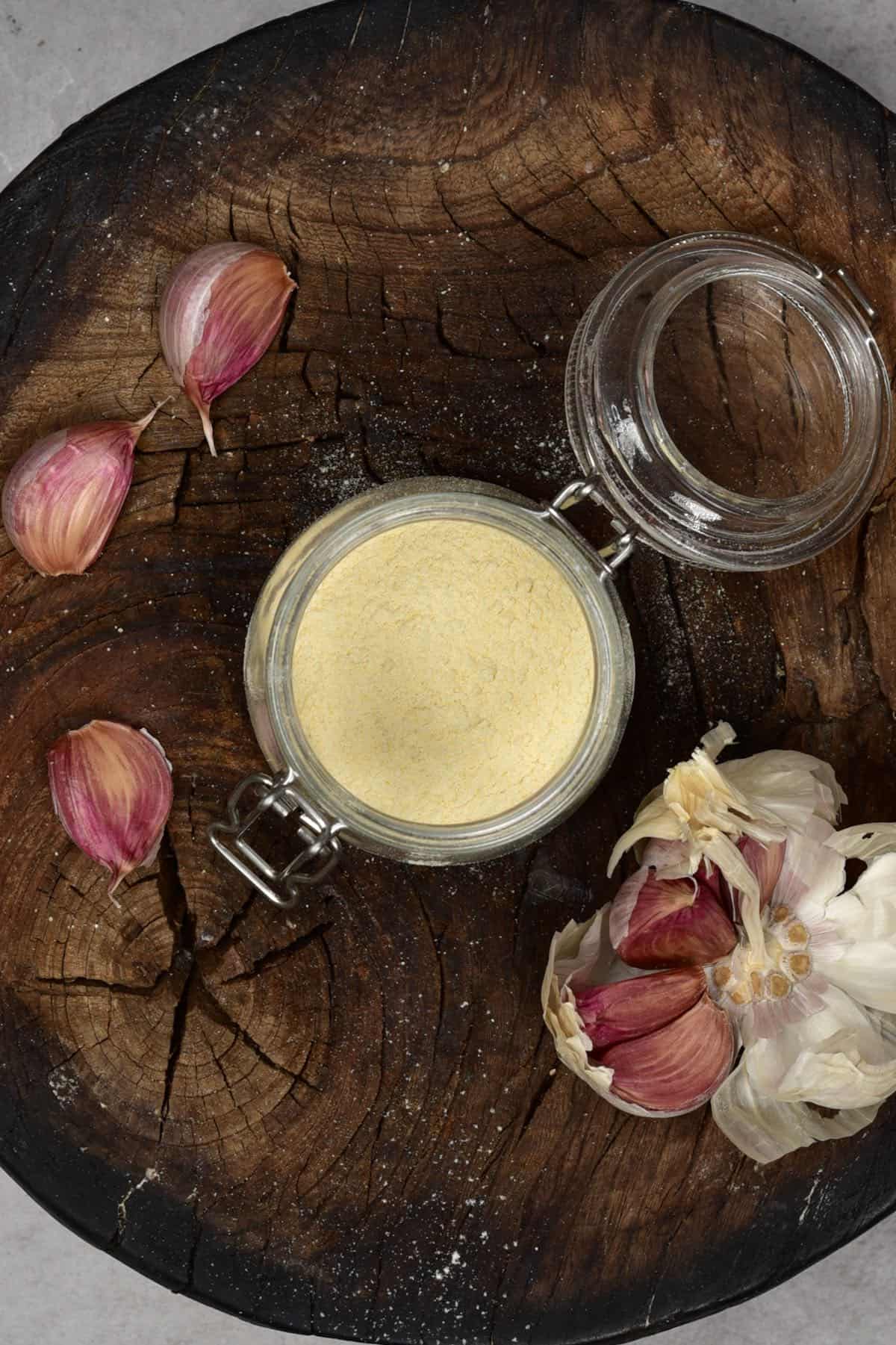
If you try this onion powder DIY, then let me know your thoughts and questions in the comments. I’d also really appreciate a DIY rating and would love to see your recreations – just tag @AlphaFoodie.
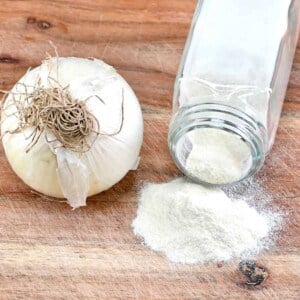
How To Make Onion Powder
Ingredients
- 4 onions white, yellow, red, sweet, etc, more or less as wanted
This will yield approx. 6 Tablespoons.
Instructions
Step 1: Prepare the Onion
- Peel and slice the onions. You can use a mandolin to get really even, thin slices. The thinner the slices, the quicker they'll dry. Aim for 1/8 inch thickness (3 mm).
Step 2: Dehydrate the Onion Flakes
With a dehydrator
- Lay the fresh chopped onion over the dehydrator trays in a single layer, taking care not to make them overlap.Dehydrate at 150ºF/66ºC for 6-8 hours (if high humidity, around 80%) or 4-6 hours (if low humidity).They are ready when they snap when trying to bend. If they're at all pliable, they need more time.
With an oven
- Spread the onion pieces over parchment-lined baking sheets, making sure the pieces don't touch or overlap and then place them in the oven at its lowest temperature. It's best if the temperature is around 130-150ºF/54-66ºC.If your oven doesn't go as low as that, then choose the lowest temperature and prop open the door with the handle of a wooden spoon or something similar, to allow for better airflow and for the steam to escape as the onion dehydrates.Check on the onion hourly, optionally flipping it over a couple of times, to dry it faster.Remove from the oven when it snaps rather than bends, or at least has a very little bend (as it should continue to crisp while cooling). Once cool, it should snap rather than bend. If not, then it’ll have to go back into the oven again.
Sun-Drying
- This option is best for warmer, non-humid climates with lots of sunshine. Colder and more humid areas will affect the drying time.Place the onion slices on a large kitchen towel/cloth or paper-lined baking tray and leave them in a well-ventilated area, near a window (if possible).Flip the onion pieces a few times to speed up the process.This method can take a few days based on the onion's thickness, weather, and humidity.
Step 3: Grind the flakes into onion powder
- You can use a food processor, blender, coffee/spice grinder, or even mortar & pestle to grind the dehydrated onion into onion powder.
- Once ground, sift the fine powder through a sieve and re-grind any leftover larger bits. The onion powder is ready.
How To Store
- Store the homemade onion powder and flakes in airtight glass jars, and keep them in a cool, dry, and dark location – like a kitchen cupboard.Give the jars a shake the first few days after dehydration, to break up any errant clumps, and optionally place some uncooked rice or beans in the jar to absorb any extra moisture, to avoid clumping.The onion powder and flakes can be stored this way for up to a year, with little decline in flavor. Just make sure to keep the jar 100% moisture-free!
Notes
- How much onion powder equals one onion? 1 tablespoon of onion powder is equal to one medium onion or around 1/2 cup chopped raw onion or 1/4 cup minced onion.
- Onion powder vs onion salt? Onion salt is a mixture of onion powder and salt. Use a ratio of 3:1 parts salt vs onion powder (e.g. 3 tsp salt to 1 tsp onion powder).
- If you use a food processor to grind the onion into powder, allow it to settle for a minute or two before opening it, otherwise, the powder tends to go everywhere!
- You can use the onions of your choice, though they will all affect the flavor in different ways.
- If you’re using homegrown onions, you can also dry the green leaves but the time to dry the leaves vs. bulb will differ.
Nutrition
Nutrition information is automatically calculated, so should only be used as an approximation.

